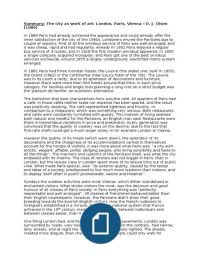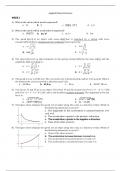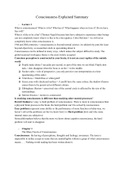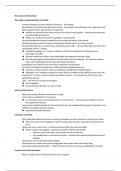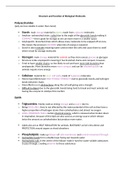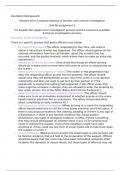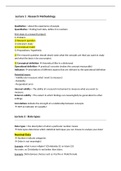Unit 1: The capitalist revolution
Economics is the study of how people interact with each other, and with the natural
environment, in producing their livelihoods.
To compare living standards in each country, we use a measure called GDP per capita. People
obtain their incomes by producing and selling goods and services. GDP per capital corresponds
here to average annual income.
1.1 income inequality
A handy measure of inequality in a country is called the 90/10 ratio, which we define here as
the average income of the richest 10% divided by the average income of the poorest 10%.
1.2 measuring income and living standards
GDP per capita is a measure of the total goods and services produced in a country, which is
then divided by the country’s population. The value of GDP corresponds to the total income
of everyone in the country. Expressed in per-capita measures average income but not
individual well-being. Real GDP accounts for price changes (inflation/deflation) over time.
GDP in PPP (purchasing power parity) accounts for price differences among countries.
Disposable income is available after paying taxes and receiving transfers from the
government. Disposable income is thought to be a good measure of living standards.
Absolute income matters for wellbeing, but we also know from research that people care
about their relative position in the income distribution. They report lower wellbeing if they
find they earn less than others in their group.
The goods and services produced by government are typically not sold, and the only measure
of their value to us is how much it cost to produce them.
The nominal GDP is calculated as follows:
(price) x (quantity) for all goods and services.
To gauge whether the economy is growing or shrinking, we need a measure of the quantity of
goods and services purchased. This is called real GDP. Constant prices are prices corrected for
increases in prices (inflation) or decreases in prices (deflation) so that a unit of currency
represents the same buying power in different periods of time. When comparing living
standards across countries, we use estimates of GDP per capita in a common set of prices
known as purchasing power parity (PPP) prices.
1.3 history’s hockey stick: growth in income
By the growth rate of income or of any other quantity, we mean the rate of change:
Growth rate = change in income / original level of income x 100%
The ratio scale is used for comparing growth rates.
1.4 the permanent technological revolution
,Industrial Revolution is a wave of technological advances and organizational changes starting
in Britain in the eighteenth century, which transformed an agrarian and craft-based economy
into a commercial and industrial economy.
In economics, technology is a process that takes a set of materials and other inputs and creates
an output. Technological progress is a change in technology that reduces the number of
resources required to produce a given amount of the output.
Rapid and sustained growth in average living since 1700.
- Ongoing technological progress
- Increase in labor productivity.
1.5 the economy and the environment
The environment also provides raw materials that we use in the production of other goods.
But the permanent technological revolution may also be part of the solution to today’s
environmental problems.
1.6 capitalism defined: private property, markets, and firms
The ‘hockey stick curve’ counts for:
- GDP per capita
- Productivity of labor
- Connectivity of the various parts of the world
- Impact of the economy on the global environment
Capitalism is an economic system characterized by a particular combination of institutions. An
economic system is a way of organizing the production and distribution of goods and services
in an entire economy. In capitalism private property, market, and firms play an important role.
Centrally planned economic system → the government controlled the production and
distribution of goods. Role of the state – public good state.
Most economies today are capitalist. An important type of private property is the equipment,
buildings, and other durable inputs used in producing goods and services. These are called
capital goods. Raw materials used in production are called intermediate inputs.
Markets differ from theft, gifts, and government orders in three aspects:
1. They are reciprocated (a good is payed for).
2. They are voluntary.
3. There is competition.
A firm is a way of organizing production with the following characteristics:
- One or more individuals own a set of capital goods that are used in production.
- They pay wages and salaries to employees.
- They direct the employees (through the managers they also employ) in the production
of goods and services.
- The goods and services are the property of the owners.
, - The owners sell the goods and services on markets with the intention of making a
profit.
In the labor market employers offer wages to individuals who may agree to work under their
direction. Economists say that employers are on the demand side of this market, while
employees are on the supply side.
Economic system can be self-regulating, even if all parts (actors) follow their self-interest
(“invisible hand”).
1.7 capitalism as an economic system
In a capitalist system, production takes place in firms. Markets and private property are
essential parts of how firms function for two reasons:
1. Inputs and outputs are private property.
2. Firms use markets to sell outputs.
The hallmark of the capitalist economic system is the private ownership of capital goods. Two
major changes accompanied the emergence of capitalism, both of which enhance the
productivity of individual workers:
1. Technology
2. Specialization
1.8 the gains from specialization
We become better at producing some things when we each focus on a limited range of
activities. This is true for three reasons:
1. Learning by doing
2. Difference in ability
3. Economies of scale → this occurs when doubling all the inputs to a production process
more than doubles the output.
Economists distinguish who is better at producing what in two ways:
1. Absolute advantage → A person or country has this in the production of a good if the
inputs it uses to produce this good are less than in some other person or country.
2. Comparative advantage → A person or country has comparative advantage in the
production of a particular good, if the cost of producing an additional unit of that good
relative to the cost of producing another good is lower than another person or
country’s cost to produce the same two goods.
Markets contribute to increasing the productivity of labor by allowing people to specialize in
the production of goods for which they have a comparative advantage, that is the things at
which they are least bad.
1.9 capitalism, causation, and history’s hockey stick
Can we conclude that capitalism caused the upward kink in the hockey stick? We want to make
causal statements in economics.
1.10 varieties of capitalism: institutions, government, and the economy
, A development state is a government that takes a leading role in promoting the process of
economic development through its public investments, subsidies of industries, education, and
other public policies.
A dynamic economy is an economy bringing sustained growth in living standards.
Where capitalism is less dynamic, the explanation might be that:
- Private property is not secure.
- Markets are not competitive.
- Firms are owned by people who survive because of their connections to government
or their privileged birth.
Governments are a large part of the economy. They change the laws and regulations that
influence how the economy works. A monopoly is a firm that is the only seller of a product.
Companies that are considered too big to fail will be saved by the government.
Capitalism can be a dynamic economic system when it combines:
- Private incentives for cost-reducing innovation.
- Firms led by those with proven ability to produce goods at low cost.
- Public policy supporting these conditions.
- A stable society, biophysical environment, and resource base.
Capitalist revolution rapid improvements in technology combined with the emergence of a
new economic system.
A political system, such as democracy or dictatorship, determines how governments will be
selected, and how those governments will make and implement decisions that affect the
population. The role of civil society is becoming more important.
1.11 economics and the economy
The economy is part of society, which in turn is part of the biosphere
Positive economics → Descriptive about phenomena, value free, and cause-and-effect
relationships.
Normative economics → How the world should be, prescribe solutions, and based on
underlying judgements.
Microeconomics → individual economic units and actors. Such as households or firms. Explain
how these units make their decisions and interact to form larger units. One product or market.
Macroeconomic → Performance of economies at an aggregate level. Understand how
economic factor and policies drive productivity, living standard, unemployment, etc.
Economics is the study of how people interact with each other, and with the natural
environment, in producing their livelihoods.
To compare living standards in each country, we use a measure called GDP per capita. People
obtain their incomes by producing and selling goods and services. GDP per capital corresponds
here to average annual income.
1.1 income inequality
A handy measure of inequality in a country is called the 90/10 ratio, which we define here as
the average income of the richest 10% divided by the average income of the poorest 10%.
1.2 measuring income and living standards
GDP per capita is a measure of the total goods and services produced in a country, which is
then divided by the country’s population. The value of GDP corresponds to the total income
of everyone in the country. Expressed in per-capita measures average income but not
individual well-being. Real GDP accounts for price changes (inflation/deflation) over time.
GDP in PPP (purchasing power parity) accounts for price differences among countries.
Disposable income is available after paying taxes and receiving transfers from the
government. Disposable income is thought to be a good measure of living standards.
Absolute income matters for wellbeing, but we also know from research that people care
about their relative position in the income distribution. They report lower wellbeing if they
find they earn less than others in their group.
The goods and services produced by government are typically not sold, and the only measure
of their value to us is how much it cost to produce them.
The nominal GDP is calculated as follows:
(price) x (quantity) for all goods and services.
To gauge whether the economy is growing or shrinking, we need a measure of the quantity of
goods and services purchased. This is called real GDP. Constant prices are prices corrected for
increases in prices (inflation) or decreases in prices (deflation) so that a unit of currency
represents the same buying power in different periods of time. When comparing living
standards across countries, we use estimates of GDP per capita in a common set of prices
known as purchasing power parity (PPP) prices.
1.3 history’s hockey stick: growth in income
By the growth rate of income or of any other quantity, we mean the rate of change:
Growth rate = change in income / original level of income x 100%
The ratio scale is used for comparing growth rates.
1.4 the permanent technological revolution
,Industrial Revolution is a wave of technological advances and organizational changes starting
in Britain in the eighteenth century, which transformed an agrarian and craft-based economy
into a commercial and industrial economy.
In economics, technology is a process that takes a set of materials and other inputs and creates
an output. Technological progress is a change in technology that reduces the number of
resources required to produce a given amount of the output.
Rapid and sustained growth in average living since 1700.
- Ongoing technological progress
- Increase in labor productivity.
1.5 the economy and the environment
The environment also provides raw materials that we use in the production of other goods.
But the permanent technological revolution may also be part of the solution to today’s
environmental problems.
1.6 capitalism defined: private property, markets, and firms
The ‘hockey stick curve’ counts for:
- GDP per capita
- Productivity of labor
- Connectivity of the various parts of the world
- Impact of the economy on the global environment
Capitalism is an economic system characterized by a particular combination of institutions. An
economic system is a way of organizing the production and distribution of goods and services
in an entire economy. In capitalism private property, market, and firms play an important role.
Centrally planned economic system → the government controlled the production and
distribution of goods. Role of the state – public good state.
Most economies today are capitalist. An important type of private property is the equipment,
buildings, and other durable inputs used in producing goods and services. These are called
capital goods. Raw materials used in production are called intermediate inputs.
Markets differ from theft, gifts, and government orders in three aspects:
1. They are reciprocated (a good is payed for).
2. They are voluntary.
3. There is competition.
A firm is a way of organizing production with the following characteristics:
- One or more individuals own a set of capital goods that are used in production.
- They pay wages and salaries to employees.
- They direct the employees (through the managers they also employ) in the production
of goods and services.
- The goods and services are the property of the owners.
, - The owners sell the goods and services on markets with the intention of making a
profit.
In the labor market employers offer wages to individuals who may agree to work under their
direction. Economists say that employers are on the demand side of this market, while
employees are on the supply side.
Economic system can be self-regulating, even if all parts (actors) follow their self-interest
(“invisible hand”).
1.7 capitalism as an economic system
In a capitalist system, production takes place in firms. Markets and private property are
essential parts of how firms function for two reasons:
1. Inputs and outputs are private property.
2. Firms use markets to sell outputs.
The hallmark of the capitalist economic system is the private ownership of capital goods. Two
major changes accompanied the emergence of capitalism, both of which enhance the
productivity of individual workers:
1. Technology
2. Specialization
1.8 the gains from specialization
We become better at producing some things when we each focus on a limited range of
activities. This is true for three reasons:
1. Learning by doing
2. Difference in ability
3. Economies of scale → this occurs when doubling all the inputs to a production process
more than doubles the output.
Economists distinguish who is better at producing what in two ways:
1. Absolute advantage → A person or country has this in the production of a good if the
inputs it uses to produce this good are less than in some other person or country.
2. Comparative advantage → A person or country has comparative advantage in the
production of a particular good, if the cost of producing an additional unit of that good
relative to the cost of producing another good is lower than another person or
country’s cost to produce the same two goods.
Markets contribute to increasing the productivity of labor by allowing people to specialize in
the production of goods for which they have a comparative advantage, that is the things at
which they are least bad.
1.9 capitalism, causation, and history’s hockey stick
Can we conclude that capitalism caused the upward kink in the hockey stick? We want to make
causal statements in economics.
1.10 varieties of capitalism: institutions, government, and the economy
, A development state is a government that takes a leading role in promoting the process of
economic development through its public investments, subsidies of industries, education, and
other public policies.
A dynamic economy is an economy bringing sustained growth in living standards.
Where capitalism is less dynamic, the explanation might be that:
- Private property is not secure.
- Markets are not competitive.
- Firms are owned by people who survive because of their connections to government
or their privileged birth.
Governments are a large part of the economy. They change the laws and regulations that
influence how the economy works. A monopoly is a firm that is the only seller of a product.
Companies that are considered too big to fail will be saved by the government.
Capitalism can be a dynamic economic system when it combines:
- Private incentives for cost-reducing innovation.
- Firms led by those with proven ability to produce goods at low cost.
- Public policy supporting these conditions.
- A stable society, biophysical environment, and resource base.
Capitalist revolution rapid improvements in technology combined with the emergence of a
new economic system.
A political system, such as democracy or dictatorship, determines how governments will be
selected, and how those governments will make and implement decisions that affect the
population. The role of civil society is becoming more important.
1.11 economics and the economy
The economy is part of society, which in turn is part of the biosphere
Positive economics → Descriptive about phenomena, value free, and cause-and-effect
relationships.
Normative economics → How the world should be, prescribe solutions, and based on
underlying judgements.
Microeconomics → individual economic units and actors. Such as households or firms. Explain
how these units make their decisions and interact to form larger units. One product or market.
Macroeconomic → Performance of economies at an aggregate level. Understand how
economic factor and policies drive productivity, living standard, unemployment, etc.

